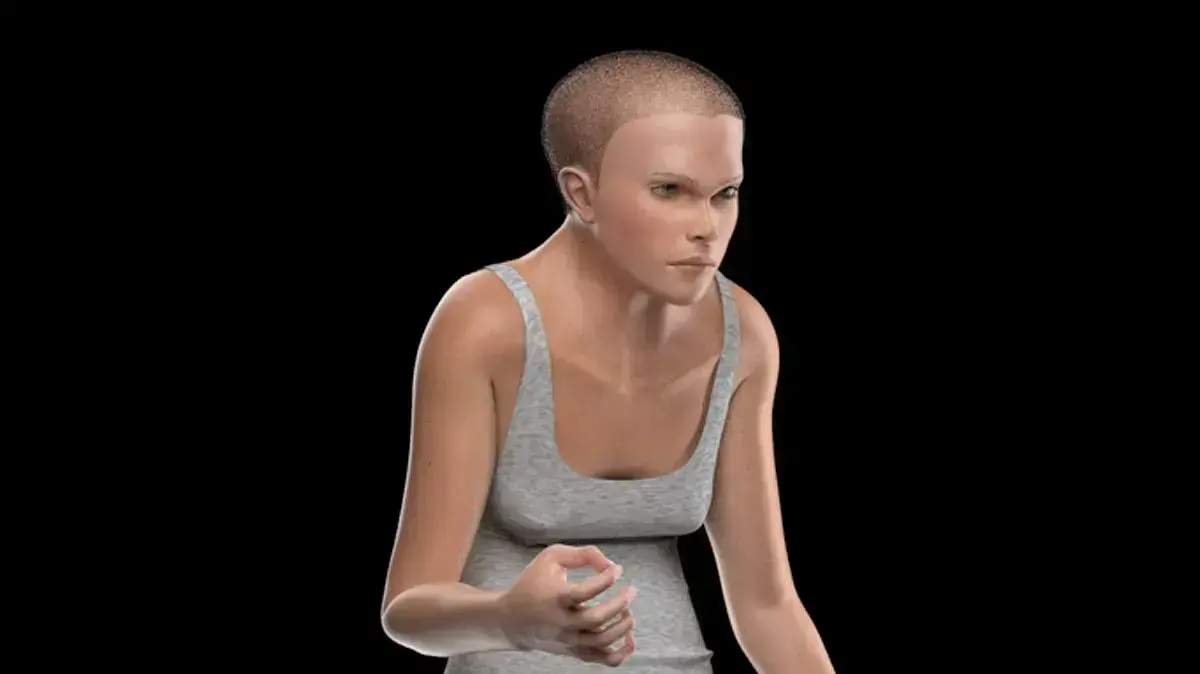For many of us, a moment when we are without our phone, tablet or laptop feels like an eternity.
But a scary glimpse into the future of the human race might encourage us to spend a little less time with these devices.
Researchers have created a grotesque model of a woman called 'Mindy', which they say provides a grounded hypothesis for the way humans might look in less than 800 years, as a result of our reliance on technology.
With a humped back, broad neck, clawed shriveled hand and even a second set of eyelids, Mindy "could be the average human from the year 3,000 onwards".
Mindy was created by Toll Free Forwarding as a way to demonstrate how technology affects our bodies.
"We gathered scientific studies done on the subject and opinions of experts in the field, before working with a 3D designer to create a future person whose body has changed physically due to consistent use of smartphones, laptops and other technologies," they explained there.
So what will we look like in the year 3,000 and why?
Simulation of the human body in the year 3,000 (photo: screenshot, tollfreeforwarding)
Years of looking down at our smartphone screens or up at computer screens will result in a hunched-over physique, according to the model.
At the same time, our hands will be permanently shaped into a claw due to the constant gripping of smartphones.
Speaking to Toll Free Forwarding, Dr Nikola Djordjevic from Med Alert Help explained: "The way we hold our phones can cause strain on certain touch points - causing 'typing claw', known in medical parlance as 'canal syndrome' the qubital".
A hand designed to hold a smartphone (photo: screenshot, tollfreeforwarding)
In addition to the 'typing claw', humans may develop 'smartphone elbow' - a fixed 90 degree angle caused by the typical position of the arm when holding a device.
"Keeping the elbow bent for a long time - often, while holding the phone - can stretch the nerve behind the elbow and put pressure on it," explained Dr. Djordavich.
Hours of looking at our phones will cause not only the back to cramp, but also the neck to thicken According to the model. "When you work on a computer or look down at your phone, the muscles at the back of the neck have to contract to hold the head up," explained Dr. K.
Daniel Rio of the Orch Spine Hospital in New York.
"The more you look down, the harder the muscles have to work to keep your head up.
Back with hump and wide neck (photo: screenshot, tollfreeforwarding)
Other grotesque features we can expect include a thicker skull and smaller brain, as well as a second eyelid to prevent excessive exposure to light.
"Humans may have developed a larger inner eyelid to prevent exposure to excessive light, or the lens of the eye may have evolved to block blue light from entering, but not other high-wavelength lights such as green, yellow or red," said Casson Ratanyaka of the University of Toledo.
Double set of eyelids (photo: screenshot, tollfreeforwarding)
But why should our brains get smaller?
"I think the best explanation for our shrinking brain size is the idiocracy theory," said cognitive researcher David Geary.
This theory was popularized by the 2006 film Idiocracy, in which an ordinary man wakes up 500 years in the future to discover that he is the most intelligent person on Earth.
It gained momentum thanks to research showing how the human brain shrank from the size it was 1.9 million years ago to 10,000 years ago.
Why?
Thanks to technological advances in agriculture, health and many other areas of life, we now have to do much less to survive.
According to evolutionary theory, not only people with larger brains will be evolutionarily selected to survive.
It could even expand and create a smaller person altogether, as Adina Mahali from "Enlightened Reality" said: "The theory of evolution points to the existence of a smaller person in the future. This is mainly due to the fact that survival no longer depends on being the largest person, or the strongest of the species . Likewise, reproductive success currently depends on a wide variety of indicators, including for example financial capabilities. In the future, the people who are more technologically savvy will likely be the most successful. In light of this, humans will begin to shrink."
This is what office workers will look like in 20 years?
"Emma" - a simulation of how office workers will look in 20 years (Fellowes Brands)
Mindy is the successor to her mother - the sick model of the working woman of the future - built in 2019 to emphasize the importance of good working conditions.
Emma was designed by researchers after interviewing more than 3,000 employees about their health issues and concerns.
She has a constant squatting position from sitting for hours every day at her desk, red and dry eyes from prolonged exposure to computer screen light and loose skin from spending years under the glare of artificial lights.
health
news
Tags
The Human Body
evolution
future

